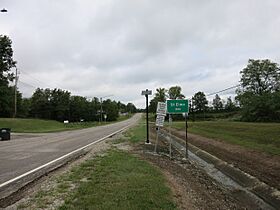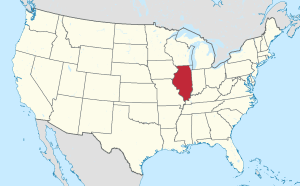St. Elmo, Illinois facts for kids
Quick facts for kids
St. Elmo
|
|
|---|---|

St. Elmo sign on Interstate Drive north of I-70.
|
|

Location of St. Elmo in Fayette County, Illinois.
|
|

Location of Illinois in the United States
|
|
| Country | United States |
| State | Illinois |
| County | Fayette |
| Area | |
| • Total | 1.51 sq mi (3.90 km2) |
| • Land | 1.48 sq mi (3.84 km2) |
| • Water | 0.02 sq mi (0.06 km2) |
| Elevation | 614 ft (187 m) |
| Population
(2020)
|
|
| • Total | 1,254 |
| • Density | 845.58/sq mi (326.46/km2) |
| Time zone | UTC-6 (CST) |
| • Summer (DST) | UTC-5 (CDT) |
| ZIP Code(s) |
62458
|
| Area code(s) | 618 |
| FIPS code | 17-66794 |
| GNIS feature ID | 2396486 |
| Wikimedia Commons | St. Elmo, Illinois |
St. Elmo is a city in Fayette County, Illinois, United States. The population was 1,254 at the 2020 census. St. Elmo was established in 1871.
Contents
Geography
St. Elmo is located at 39°1′36″N 88°51′7″W / 39.02667°N 88.85194°W (39.026709, -88.852062).
According to the 2021 census gazetteer files, St. Elmo has a total area of 1.51 square miles (3.91 km2), of which 1.48 square miles (3.83 km2) (or 98.41%) is land and 0.02 square miles (0.05 km2) (or 1.59%) is water.
History
A bill to fund the National Road was signed in 1806 by President Thomas Jefferson. The highway ran from Cumberland, Maryland west to the Mississippi River. The road was designed as a route for pioneers to settle the region. U.S. Route 40 follows the course of the National Road through the state of Illinois. A hamlet known as Howard's Point was established on the National Road at the current location. Later, the name was changed to St. Elmo when a north-south railroad was planned in 1882 to terminate at the settlement. By 1895, the planned railroad bypassed the town, but an east-west railroad was constructed that connected with Vandalia. The town constructed a rail link to the Chicago, Paducah and Memphis Railroad.
Smith Aviation Field was built in 1926 on the west side of town, and it became popular for stunt flying, wing walkers, and parachute jumping. Charles Lindbergh was a regular visitor. A local oil boom in the late 1930s caused St. Elmo to be known as "Little Tulsa" and oil company executives often flew into Smith Aviation Field, which is now abandoned.
Demographics
| Historical population | |||
|---|---|---|---|
| Census | Pop. | %± | |
| 1870 | 273 | — | |
| 1880 | 323 | 18.3% | |
| 1890 | 354 | 9.6% | |
| 1900 | 1,050 | 196.6% | |
| 1910 | 1,227 | 16.9% | |
| 1920 | 1,337 | 9.0% | |
| 1930 | 1,329 | −0.6% | |
| 1940 | 2,290 | 72.3% | |
| 1950 | 1,716 | −25.1% | |
| 1960 | 1,503 | −12.4% | |
| 1970 | 1,676 | 11.5% | |
| 1980 | 1,611 | −3.9% | |
| 1990 | 1,473 | −8.6% | |
| 2000 | 1,456 | −1.2% | |
| 2010 | 1,426 | −2.1% | |
| 2020 | 1,254 | −12.1% | |
| U.S. Decennial Census | |||
As of the 2020 census there were 1,254 people, 534 households, and 372 families residing in the city. The population density was 832.12 inhabitants per square mile (321.28/km2). There were 565 housing units at an average density of 374.92 per square mile (144.76/km2). The racial makeup of the city was 96.73% White, 0.24% African American, 0.00% Native American, 0.16% Asian, 0.00% Pacific Islander, 0.56% from other races, and 2.31% from two or more races. Hispanic or Latino of any race were 1.28% of the population.
There were 534 households, out of which 26.0% had children under the age of 18 living with them, 48.13% were married couples living together, 14.79% had a female householder with no husband present, and 30.34% were non-families. 24.72% of all households were made up of individuals, and 15.17% had someone living alone who was 65 years of age or older. The average household size was 3.28 and the average family size was 2.67.
The city's age distribution consisted of 24.1% under the age of 18, 9.3% from 18 to 24, 20.7% from 25 to 44, 28.8% from 45 to 64, and 17.3% who were 65 years of age or older. The median age was 40.3 years. For every 100 females, there were 90.9 males. For every 100 females age 18 and over, there were 103.5 males.
The median income for a household in the city was $43,913, and the median income for a family was $50,662. Males had a median income of $31,528 versus $22,750 for females. The per capita income for the city was $19,890. About 14.0% of families and 22.1% of the population were below the poverty line, including 51.0% of those under age 18 and 4.5% of those age 65 or over.
Education
St. Elmo is home to St. Elmo Community School District #202, which consists of the St. Elmo Elementary School, located at 519 West 2nd Street and the St. Elmo Jr/Sr High School located at the far northern edge of town at 300 West 12th Street.
See also
 In Spanish: St. Elmo (Illinois) para niños
In Spanish: St. Elmo (Illinois) para niños

